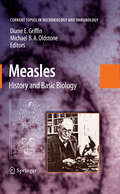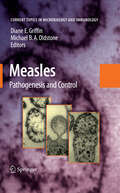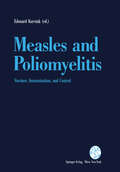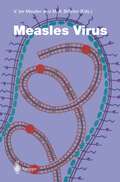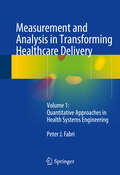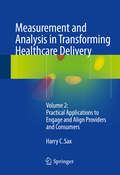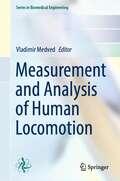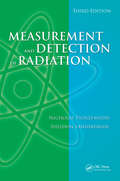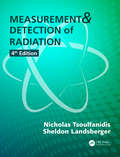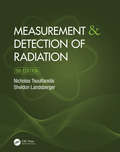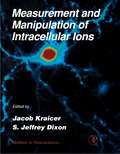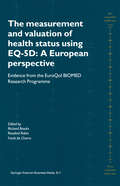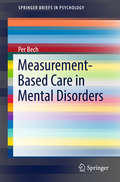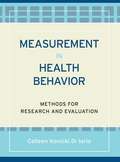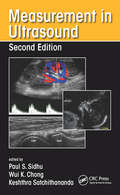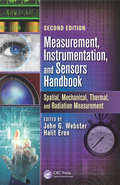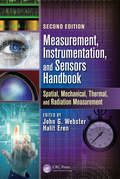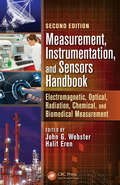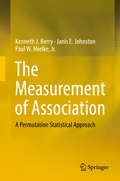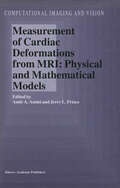- Table View
- List View
Measles: History and Basic Biology (Current Topics in Microbiology and Immunology #329)
by Diane E. Griffin Michael B. A. OldstoneMeasles virus, one of the most contagious of all human viruses, has been largely contained by the development and use of a vaccine that was introduced 50 years ago. These two volumes were timed to honor the introduction of the vaccine and to record the enormous advancements made in understanding the molecular and cell biology, pathogenesis, and control of this infectious disease. Where vaccine has been effectively delivered, endemic measles virus transmission has been eliminated. However, difficulties in vaccine delivery, lack of health care support and objection to vaccination in some communities continue to result in nearly 40 million cases and over 300,000 deaths per year from measles.
Measles: Pathogenesis and Control (Current Topics in Microbiology and Immunology #330)
by Diane E. Griffin Michael B. A. OldstoneMeasles virus, one of the most contagious of all human viruses, has been largely contained by the development and use of a vaccine that was introduced 50 years ago. These two volumes were timed to honor the introduction of the vaccine and to record the enormous advancements made in understanding the molecular and cell biology, pathogenesis, and control of this infectious disease. Where vaccine has been effectively delivered, endemic measles virus transmission has been eliminated. However, difficulties in vaccine delivery, lack of health care support and objection to vaccination in some communities continue to result in nearly 40 million cases and over 300,000 deaths per year from measles.
Measles and Poliomyelitis: Vaccines, Immunization, and Control
by Edouard KurstakElimination of measles and poliomyelitis diseases from the globe is a priority goal of the World Health Organization. For the first time, in a single volume comprising thirty-one well-documented chapters, internationally recognized experts provide a state-of-the-art treatment of these two important viral diseases. The book offers a wide range of new findings and references on the latest advances regarding the measles and poliomyelitis: • global and molecular genetic epidemiology, characteristics and diseases surveillance • all available vaccines and research to produce more safe and more potent-biotechnology vaccines • immunization programmes, considering the available vaccines and possibility of vaccinal associations in strategy to eliminate/eradicate these diseases • immunity to infections and immunogenicity of vaccines • virus genomes organization and antigenic structures related to vaccine characteristics, stressing their role in immunization strategies • needs of global cooperation, using all available resources, vaccines and strategies to achieve the global control of the diseases. It is addressed to all public health professionals concerned with measles and poliomyelitis control, especially in hospitals, clinics, governmental health services, international health services, centers of infectious diseases, research institutes, medical schools, vaccine producers and experts in immunization strategies and programmes.
Measles Virus (Current Topics in Microbiology and Immunology #191)
by Volker Ter Meulen Martin F. BachMeasles, also called the greatest killer of children in history, still annually affects about 50 million individuals and causes close to a million deaths primarily in developing countries. Before the advent of measles vaccine some 30 years ago, these figures were roughly three times higher. Attenuated measles virus (MV) strains, all quite closely related to the original Edmonston isolate, have a very good record as a safe and highly efficacious vaccine and have brought down the measles toll in industrialized countries to almost negligible levels. However, recent outbreaks in the USA and Europe have again brought the measles problem to public attention. Sadly enough, these outbreaks were more instrumental in inducing activities to drastically reduce and hopefully finally eradicate measles than were the ten thousand times higher number of victims in developing countries. To reach this goal, as detailed in this volume, apparently it is not enough to of the existing vaccine as was the rigorously enforce use case with smallpox eradication: the intricacies of measles disease phenomena, in particular the generalized immune suppression which favors secondary infections, require more basic knowledge of the virus-host interactions and probably the development of new vaccines for special applications such as first immunizations of very young infants in developing countries.
Measurement and Analysis in Transforming Healthcare Delivery: Volume 1: Quantitative Approaches in Health Systems Engineering
by Peter J. FabriThis volume provides the important concepts necessary for a physician to participate in a reengineering process, develop decision-making skills based on probability and logic rather than “rules,” and to measure and analyze meaningful outcomes of care delivery. This approach has been developed over ten years in a medical student-based program and has been enthusiastically embraced by medical students without backgrounds in engineering or statistics. More specifically, this text will introduce physicians to relevant and available computer software, combined with an in depth knowledge of measurement, variation, and uncertainty. It provides a basis for the transformation of data into information, information into knowledge, and knowledge into wisdom. The first quarter of the book will address understanding and visualizing data, using statistical and graphic analysis. The next quarter addresses the fundamentals of applied statistics, and the application of conditional probability to clinical decision making. The next quarter addresses the four “cornerstones” of modern analytics: regression, classification, association analysis, and clustering. The final section addresses the identification of outliers and their importance in understanding, the assessment of cause and effect and the limitations associated with retrospective data analysis. This toolbox will prepare the interested physician to actively engage in the identification of problem areas, the design of process-based solutions, and the continuous assessment of outcomes of clinical practice. Armed with this toolbox, the reader will be “prepared to make a difference” in the rapidly changing world of healthcare delivery.Measurement and Analysis in Transforming Healthcare Delivery is an excellent resource for general practitioners, health administrators, and all medical professionals interacting with healthcare delivery.
Measurement and Analysis in Transforming Healthcare Delivery: Volume 2: Practical Applications to Engage and Align Providers and Consumers
by Harry C. SaxThis volume is complementary to Volume 1: Quantitative Approaches in Health Systems Engineering which provides in-depth analysis of the statistical and quantitative aspects of Health Systems Engineering. Volume 2: Practical Applications to Engage and Align Providers and Consumers builds upon these concepts with the integration of additional economic, performance and quality measures. Stressing the importance of changes in the economics of health care financing, it will serve as a resource for not only leaders of organizations, but also providers who will be practicing a different type of medicine from that of which they were trained. After defining the challenges, the authors will quantify and define funds flows and various margins necessary for viability, how providers will be measured and rewarded for quality, and the importance of accurate dashboard of physician performance. Types of payment systems, including capitation, ACOs, risk contracts, and hybrid forms of fee for service will be defined and their relative advantages discussed. Lessons from other countries that provide high quality care at a lower cost will be examined for applicability to our challenges. Finally, experts in leadership will focus on influencing behavior to achieve results while remembering that healthcare is about the patient. This textbook will serve as a useful resource for clinicians, healthcare executives, governmental agencies, and emerging leaders in organizations.
Measurement and Analysis of Human Locomotion (Series in Biomedical Engineering)
by Vladimir MedvedThis book addresses instruments, methodologies and diagnostic methods used to evaluate and diagnose human movement, locomotion and physical status in general. Starting from historical perspective, the idea of understanding human locomotion by applying technical measurement devices and incorporating measurement data into physical representation of gross body movement is presented and explained, an approach known as inverse dynamics. With this approach as a kind of umbrella concept, components of measurement systems including relevant signal and data processing methods are described. Modern instruments to capture body movement by measuring its kinematics, kinetics and surface electromyography (sEMG) are thus described; all systems being used dominantly—if not exclusively—in a movement analysis laboratory setting. Focusing mainly on human posture and gait, but including also examples of movement patterns from selected kinesiological and sports activities, the book attempts to present essentials of biomechanics and biomedical engineering approach to this subject matter. It illustrates how data collected and elaborated by modern engineering technology can complement traditional expert knowledge of a kinesiologist or a medical doctor. The book is applicable in the fields of sports, physical activities, as well as in medical diagnostics and rehabilitation. The examples of this book’s practical application might be in evaluation of efficiency of human gait, in evaluation of skeletal muscle fatigue in physical exercise, in biomechanical diagnostics of traumatological conditions requiring orthopaedic treatment and the like. This book can also be used in planning and executing research endeavours, particularly in a clinical context as a reference for various diagnostics procedures. It presents the lecture notes of a course carrying the same name within Medical Studies in English at the University of Zagreb for more than a decade.
Measurement and Detection of Radiation
by Nicholas TsoulfanidisThe research and applications of nuclear instrumentation have grown substantially since publication of the previous editions. With the miniaturization of equipment, increased speed of electronic components, and more sophisticated software, radiation detection systems are now more productively used in many disciplines, including nuclear nonprolifera
Measurement and Detection of Radiation
by Nicholas Tsoulfanidis Sheldon LandsbergerA Sound Introduction to Radiation Detection and Measurement for Newcomers to Nuclear Science and EngineeringSince the publication of the bestselling third edition, there have been advances in the field of radiation detection, most notably in practical applications. Incorporating these important developments, Measurement and Detection of Radiation,
Measurement and Detection of Radiation
by Nicholas Tsoulfanidis Sheldon LandsbergerAs useful to students and nuclear professionals as its popular predecessors, this fifth edition provides the most up-to-date and accessible introduction to radiation detector materials, systems, and applications. There have been many advances in the field of radiation detection, most notably in practical applications. Incorporating these important developments, Measurement and Detection of Radiation, Fifth Edition provides the most up-to-date and accessible introduction to radiation detector materials, systems, and applications. It also includes more problems and updated references and bibliographies, and step-by-step derivations and numerous examples illustrate key concepts. New to the Fifth Edition:• Expanded chapters on semiconductor detectors, data analysis methods, health physics fundamentals, and nuclear forensics.• Updated references and bibliographies.• New and expanded problems.
Measurement and Detection of Radiation
by Nicholas Tsoulfanidis Sheldon LandsbergerAs useful to students and nuclear professionals as its popular predecessors, this fifth edition provides the most up-to-date and accessible introduction to radiation detector materials, systems, and applications. There have been many advances in the field of radiation detection, most notably in practical applications. Incorporating these important developments, Measurement and Detection of Radiation, Fifth Edition provides the most up-to-date and accessible introduction to radiation detector materials, systems, and applications. It also includes more problems and updated references and bibliographies, and step-by-step derivations and numerous examples illustrate key concepts. New to the Fifth Edition:• Expanded chapters on semiconductor detectors, data analysis methods, health physics fundamentals, and nuclear forensics.• Updated references and bibliographies.• New and expanded problems.
Measurement and Manipulation of Intracellular Ions (ISSN #Volume 27)
by P. Michael Conn Jacob Kracier S. Jeffrey DixonThis practical book provides the detailed methodology and expert guidance required for measuring and manipulating cytosolic ion concentrations. In addition, the strengths, weaknesses, and pitfalls of various techniques are presented. It is an invaluable source for those needing an objective evaluation of current methodologies and for those contemplating setting up such procedures.A one-source reference for measuring and manipulating intracellular ions and for comparing and evaluating current methodologiesIncludes overviews of Optical probes and reagentsFabrication and use of ion-selective microelectrodesUse of NMR spectroscopyIonophores
The Measurement and Valuation of Health Status Using EQ-5D: Evidence from the EuroQol BIOMED Research Programme
by FrankCharro RosalindRabin RichardBrooksEQ-5D from the EuroQol Group is a standardised, non-disease-specific instrument for describing and valuing health. It is in widespread use in many countries and has been applied in many different settings. EQ-5D is now an integral feature of many clinical trials and is increasingly used in population health surveys. This book reports on the results of the European Union-funded EQ-net project which furthered the development of EQ-5D in the key areas of valuation, application and translation. The primary effort concentrated on harmonising and integrating the results of the various EuroQol valuation projects. Most importantly, the book includes a set of VAS-based preference weights for all the EQ-5D health states based on cross-European EQ-5D data. This book provides the most comprehensive account to date of the EuroQol Group endeavour. It will appeal to clinicians, nurses, health services researchers, health economists, those responsible for audit and quality assurance, public health specialists and managers in health care institutions, and the pharmaceutical industry.
Measurement-Based Care in Mental Disorders (SpringerBriefs in Psychology)
by Per BechThis innovative monograph introduces a measurement-based framework for effective treatment of patients with mood disorders, personality disorders, and schizophrenia. Rooted firmly in principles of pharmacotherapy and clinical psychometrics, the book’s signature diagram balances rating scale results and patient self-reported progress along three angles: therapeutic effects, adverse effects, and quality of life. The author’s choices of measures are brief, valid, widely used, and easy for clinicians to administer and patients to understand. But rather than being a mechanistic or an impersonal formula, this system is shown as a science-based means of fostering constructive collaboration between patient and therapist, leading to greater patient well-being. Included in the coverage: · Negative mental health: the ordinary symptom-orientated mental disorders.· The basic diagram of personality dimensions.· Self-reported symptom scales within the basic diagram.· Clinician-administered symptom scales within the basic diagram.· The pharmacopsychometric triangle in measurement-based care.· Diagnostic rating scales.· A practical outcome evaluation plan.Offering a medical level of precision to mental health, Measurement-Based Care in Mental Disorders should interest health care providers at all levels, particularly physicians and staff in primary care settings, and in psychiatric in- and outpatient clinics, including psychiatrists, psychologists, nurses, and social workers.
Measurement in Health Behavior: Methods for Research and Evaluation (Jossey-Bass Public Health #1)
by Colleen Konicki DiIorioMeasurement in Health Behavior offers faculty, students, researchers, and public health professionals the information they need to improve their knowledge of instrument development and testing and their understanding of reliability and validity testing discussed in articles and reports. The book also helps improve students’ and professionals’ ability to conduct basic tests for reliability and validity and hones their skills in interpreting the results of data analysis. Based on data collected from the author’s more than ten years of research and program development, Measurement in Health Behavior provides realistic examples from the public health arena to clearly demonstrate the book’s concepts.
Measurement in Ultrasound
by Paul S. Sidhu Wui K. Chong Keshthra SatchithanandaMeasurement and interpretation of key ultrasound parameters are essential to differentiate normal anatomy from pathology. By using Measurement in Ultrasound, trainee radiologists and ultrasonographers can gain an appreciation of such measurements, while practitioners can use it as a valuable reference in the clinical setting. The book follows a consistent format throughout for ease of reference and features useful information on preparation and positioning of the patient for ultrasound, the type of transducer and method to be used, the appearance of the resulting ultrasound images and the measurements to be derived from them. Designed for frequent use in everyday practice, the book includes more than 150 high-quality ultrasound images annotated with key measurements and accompanied by concise explanatory text. Normal variants are provided, along with ranges for features that can change during development and in disease. This new edition covers relevant developments in ultrasound. Where appropriate, updated ultrasound measurements that have arisen are also included and key references are provided as an aid to further study.
Measurement in Ultrasound: A Practical Handbook
by Paul S. Sidhu Wui K. Chong Keshthra SatchithanandaMeasurement and interpretation of key ultrasound parameters are essential to differentiate normal anatomy from pathology. By using Measurement in Ultrasound, trainee radiologists and ultrasonographers can gain an appreciation of such measurements, while practitioners can use it as a valuable reference in the clinical setting. The book follows a consistent format throughout for ease of reference and features useful information on preparation and positioning of the patient for ultrasound, the type of transducer and method to be used, the appearance of the resulting ultrasound images and the measurements to be derived from them. Designed for frequent use in everyday practice, the book includes more than 150 high-quality ultrasound images annotated with key measurements and accompanied by concise explanatory text. Normal variants are provided, along with ranges for features that can change during development and in disease. This new edition covers relevant developments in ultrasound. Where appropriate, updated ultrasound measurements that have arisen are also included and key references are provided as an aid to further study.
Measurement, Instrumentation, and Sensors Handbook: Spatial, Mechanical, Thermal, and Radiation Measurement (Electrical Engineering Handbook Ser.)
by John G. Webster Halit ErenThe Second Edition of the bestselling Measurement, Instrumentation, and Sensors Handbook brings together all aspects of the design and implementation of measurement, instrumentation, and sensors. Reflecting the current state of the art, it describes the use of instruments and techniques for performing practical measurements in engineering, physics, chemistry, and the life sciences and discusses processing systems, automatic data acquisition, reduction and analysis, operation characteristics, accuracy, errors, calibrations, and the incorporation of standards for control purposes. Organized according to measurement problem, the Spatial, Mechanical, Thermal, and Radiation Measurement volume of the Second Edition: Contains contributions from field experts, new chapters, and updates to all 96 existing chapters Covers instrumentation and measurement concepts, spatial and mechanical variables, displacement, acoustics, flow and spot velocity, radiation, wireless sensors and instrumentation, and control and human factors A concise and useful reference for engineers, scientists, academic faculty, students, designers, managers, and industry professionals involved in instrumentation and measurement research and development, Measurement, Instrumentation, and Sensors Handbook, Second Edition: Spatial, Mechanical, Thermal, and Radiation Measurement provides readers with a greater understanding of advanced applications.
Measurement, Instrumentation, and Sensors Handbook: Spatial, Mechanical, Thermal, and Radiation Measurement
by John G. Webster Halit ErenThe Second Edition of the bestselling Measurement, Instrumentation, and Sensors Handbook brings together all aspects of the design and implementation of measurement, instrumentation, and sensors. Reflecting the current state of the art, it describes the use of instruments and techniques for performing practical measurements in engineering, physics, chemistry, and the life sciences and discusses processing systems, automatic data acquisition, reduction and analysis, operation characteristics, accuracy, errors, calibrations, and the incorporation of standards for control purposes. Organized according to measurement problem, the Spatial, Mechanical, Thermal, and Radiation Measurement volume of the Second Edition: Contains contributions from field experts, new chapters, and updates to all 96 existing chapters Covers instrumentation and measurement concepts, spatial and mechanical variables, displacement, acoustics, flow and spot velocity, radiation, wireless sensors and instrumentation, and control and human factors A concise and useful reference for engineers, scientists, academic faculty, students, designers, managers, and industry professionals involved in instrumentation and measurement research and development, Measurement, Instrumentation, and Sensors Handbook, Second Edition: Spatial, Mechanical, Thermal, and Radiation Measurement provides readers with a greater understanding of advanced applications.
Measurement, Instrumentation, and Sensors Handbook: Two-Volume Set (Electrical Engineering Handbook)
by John G. Webster Halit ErenThis new edition of the bestselling Measurement, Instrumentation, and Sensors Handbook brings together all aspects of the design and implementation of measurement, instrumentation, and sensors. Reflecting the current state of the art, it describes the use of instruments and techniques for performing practical measurements in engineering, physics, chemistry, and the life sciences; explains sensors and the associated hardware and software; and discusses processing systems, automatic data acquisition, reduction and analysis, operation characteristics, accuracy, errors, calibrations, and the incorporation of standards for control purposes. Organized according to measurement problem, the Second Edition: Consists of 2 volumes Features contributions from 240+ field experts Contains 53 new chapters, plus updates to all 194 existing chapters Addresses different ways of making measurements for given variables Emphasizes modern intelligent instruments and techniques, human factors, modern display methods, instrument networks, and virtual instruments Explains modern wireless techniques, sensors, measurements, and applications A concise and useful reference for engineers, scientists, academic faculty, students, designers, managers, and industry professionals involved in instrumentation and measurement research and development, Measurement, Instrumentation, and Sensors Handbook, Second Edition provides readers with a greater understanding of advanced applications.
Measurement, Instrumentation, and Sensors Handbook: Electromagnetic, Optical, Radiation, Chemical, and Biomedical Measurement (Electrical Engineering Handbook Ser.)
by John G. Webster Halit ErenThe Second Edition of the bestselling Measurement, Instrumentation, and Sensors Handbook brings together all aspects of the design and implementation of measurement, instrumentation, and sensors. Reflecting the current state of the art, it describes the use of instruments and techniques for performing practical measurements in engineering, physics, chemistry, and the life sciences and discusses processing systems, automatic data acquisition, reduction and analysis, operation characteristics, accuracy, errors, calibrations, and the incorporation of standards for control purposes. Organized according to measurement problem, the Electromagnetic, Optical, Radiation, Chemical, and Biomedical Measurement volume of the Second Edition: Contains contributions from field experts, new chapters, and updates to all 98 existing chapters Covers sensors and sensor technology, time and frequency, signal processing, displays and recorders, and optical, medical, biomedical, health, environmental, electrical, electromagnetic, and chemical variables A concise and useful reference for engineers, scientists, academic faculty, students, designers, managers, and industry professionals involved in instrumentation and measurement research and development, Measurement, Instrumentation, and Sensors Handbook, Second Edition: Electromagnetic, Optical, Radiation, Chemical, and Biomedical Measurement provides readers with a greater understanding of advanced applications.
Measurement, Instrumentation, and Sensors Handbook: Electromagnetic, Optical, Radiation, Chemical, and Biomedical Measurement
by John G. Webster Halit ErenThe Second Edition of the bestselling Measurement, Instrumentation, and Sensors Handbook brings together all aspects of the design and implementation of measurement, instrumentation, and sensors. Reflecting the current state of the art, it describes the use of instruments and techniques for performing practical measurements in engineering, physics, chemistry, and the life sciences and discusses processing systems, automatic data acquisition, reduction and analysis, operation characteristics, accuracy, errors, calibrations, and the incorporation of standards for control purposes. Organized according to measurement problem, the Electromagnetic, Optical, Radiation, Chemical, and Biomedical Measurement volume of the Second Edition: Contains contributions from field experts, new chapters, and updates to all 98 existing chapters Covers sensors and sensor technology, time and frequency, signal processing, displays and recorders, and optical, medical, biomedical, health, environmental, electrical, electromagnetic, and chemical variables A concise and useful reference for engineers, scientists, academic faculty, students, designers, managers, and industry professionals involved in instrumentation and measurement research and development, Measurement, Instrumentation, and Sensors Handbook, Second Edition: Electromagnetic, Optical, Radiation, Chemical, and Biomedical Measurement provides readers with a greater understanding of advanced applications.
Measurement, Instrumentation, and Sensors Handbook: Two-Volume Set (Electrical Engineering Handbook)
by John G. Webster Halit ErenThis new edition of the bestselling Measurement, Instrumentation, and Sensors Handbook brings together all aspects of the design and implementation of measurement, instrumentation, and sensors. Reflecting the current state of the art, it describes the use of instruments and techniques for performing practical measurements in engineering, physics, chemistry, and the life sciences; explains sensors and the associated hardware and software; and discusses processing systems, automatic data acquisition, reduction and analysis, operation characteristics, accuracy, errors, calibrations, and the incorporation of standards for control purposes. Organized according to measurement problem, the Second Edition: Consists of 2 volumes Features contributions from 240+ field experts Contains 53 new chapters, plus updates to all 194 existing chapters Addresses different ways of making measurements for given variables Emphasizes modern intelligent instruments and techniques, human factors, modern display methods, instrument networks, and virtual instruments Explains modern wireless techniques, sensors, measurements, and applications A concise and useful reference for engineers, scientists, academic faculty, students, designers, managers, and industry professionals involved in instrumentation and measurement research and development, Measurement, Instrumentation, and Sensors Handbook, Second Edition provides readers with a greater understanding of advanced applications.
The Measurement of Association: A Permutation Statistical Approach
by Kenneth J. Berry Janis E. Johnston Paul W. Mielke Jr.This research monograph utilizes exact and Monte Carlo permutation statistical methods to generate probability values and measures of effect size for a variety of measures of association. Association is broadly defined to include measures of correlation for two interval-level variables, measures of association for two nominal-level variables or two ordinal-level variables, and measures of agreement for two nominal-level or two ordinal-level variables. Additionally, measures of association for mixtures of the three levels of measurement are considered: nominal-ordinal, nominal-interval, and ordinal-interval measures. Numerous comparisons of permutation and classical statistical methods are presented.Unlike classical statistical methods, permutation statistical methods do not rely on theoretical distributions, avoid the usual assumptions of normality and homogeneity of variance, and depend only on the data at hand. This book takes a unique approach to explaining statistics by integrating a large variety of statistical methods, and establishing the rigor of a topic that to many may seem to be a nascent field. This topic is relatively new in that it took modern computing power to make permutation methods available to those working in mainstream research.Written for a statistically informed audience, it is particularly useful for teachers of statistics, practicing statisticians, applied statisticians, and quantitative graduate students in fields such as psychology, medical research, epidemiology, public health, and biology. It can also serve as a textbook in graduate courses in subjects like statistics, psychology, and biology.
Measurement of Cardiac Deformations from MRI: Physical and Mathematical Models (Computational Imaging and Vision #23)
by A. A. Amini Jerry L. PrinceMeasurement of Cardiac Deformations from MRI: Physical and Mathematical Models describes the latest imaging and imag analysis techniques that have been developed at leading centers for the visualization, analysis, and understanding of normal and abnormal cardiac motion with magnetic resonance imaging (MRI). The use of MRI in measuring cardiac motion is particularly important because MRI is non-invasive, and it is the only modality capable of imaging detailed intramural motion within the myocardium. Biomedical engineers, medical physicists, computer scientists, and physicians interested in learning about the latest advances in cardiovascular MRI should find this book to be a valuable educational resource. In particular, it is more tutorial in nature than most of the technical papers where the research was originally published. Practitioners and researchers working in the field of cardiovascular MRI will find the book to be filled with practical technical details and references to other work, enabling the implementation of existing methods and serving as a basis for further research in the area.
